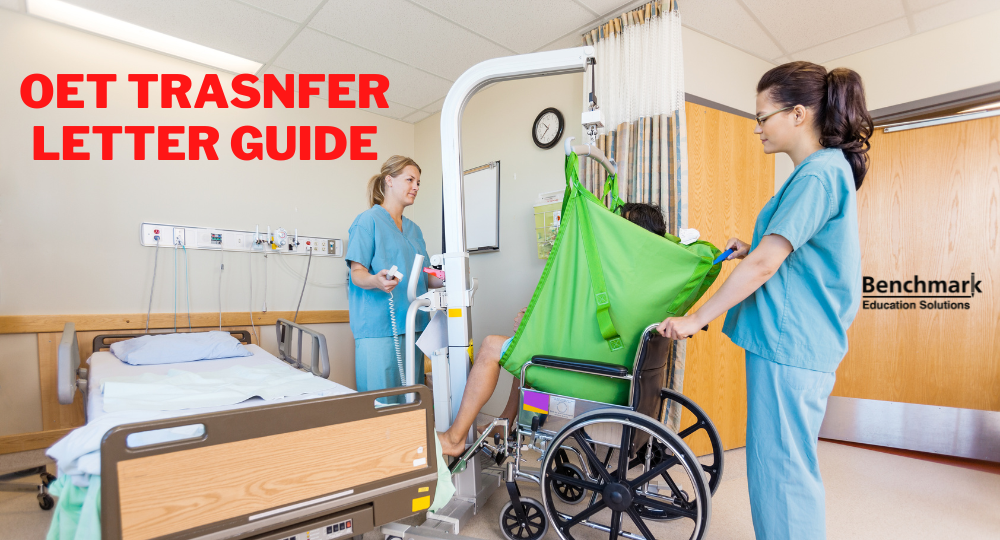

OET letter writing is categorised in 3 types mainly. These are
It’s important to note that regardless of the type of letter, the approach to writing an OET letter is the same.
A transfer letter is usually addressed to a medical professional requesting further care/treatment/management after a change in the patient’s residential location.
In this scenario, the patient undergoes appropriate investigations/treatment/care in one place/hospital/department (where the patient is ‘staying’) and needs to be transferred to a new place/hospital/department of the same hospital (where the patient has to ‘stay’) for continuity of investigations/treatment/care.
NOTE:
- This type of letters sounds similar to referral letters as the patient is introduced to the addressee for the first time. However, no change in the patient’s residential location occurs in a referral letter.
- This may also sound like a discharge letter as some case notes may include the word ‘discharge’ in places. However, a discharge letter is written after the patient completes the admission/hospitalization in a medical facility and is returned to his/her residential place. The continuity of care is then the responsibility of the patient’s GP/a medical professional who treats the patient. (However, the patient can be discharged to a new facility as well.)
Therefore, read the case notes carefully.
Given below is the composition of a sample transfer letter based on Official OET Case notes,
Follow the 38 tips given in the sample, and you will find that securing A or B for OET writing sub-test is much easier than thought.
Table of Contents
- OET Case Notes for Transfer Letter (Nursing)
- Date, Recipient’s Address, Greeting and Re: Line
- Introduction – Patient, Medical Issue & the Purpose
- Body Paragraph 1 – Medical History
- Body Paragraph 2 – Possible Complications of Diabetes
- Body Paragraph 3 – Latest information about the patient
- Conclusion – Expected care/action by the reader
- Closing Sentence – Not Included in Word Count
- Complimentary Close – Yours…
- Mock Test – Test Your Writing Skills
- Final Sample Letter
- Quiz – Check Your Knowledge
The following scenario is based on the patient’s plan to relocate from his hometown to another place.
| OET Case Notes (SOURCE) Transfer Letter (Nursing) |
Summary of the case notes:
- The patient plans to relocate from his hometown to daughter’s place.
- Therefore, there is a change in his residential location, and his further care is being transferred from the community health nurse in Newtown to the community health nurse in Centreville.
- The patient has relevant past medical history and related complications
Let us structure the first part of the sample referral letter and see what information should be included there.
| Date, Recipient’s Address, Greeting and Re: Line |
| Date (Given in the case notes as ‘Assume that today’s date is …’) Designation/Job title (The recipient’s name is not given) Greeting (Dear ……. ) Reference line (Re: the patient’s full name & DOB) Tip 1: ‘20 January 2022’ is the preferred date format at the start. Tip 2: dd/mm/yyyy is the preferred date format in in the reference line and paragraphs. (Avoid switching date formats in the reference line and paragraphs.) Tip 3: Interchanging the order of Date & Recipient’s Details is acceptable. Tip 4: Interchanging the order of Greeting & Reference Line is acceptable. Tip 5: If the name of the recipient is not given in the case notes, use appropriate title or job profile name (Dear Doctor, Dear Nurse, etc.). In this case, the designation is ‘Community Health Nurse’; therefore, you may use ‘Nurse’. Tip 6: If date of birth (DOB) is given, write that in the reference line. If age is also given, mention that in introduction. Tip 7: Watch the spelling. If you are using British/American spelling, be consistent in the letter. Avoid mixing the styles. 22 January 2019 The Community Health Nurse Dear Nurse RE: Mr Peter Dunbar, DOB: 18/03/1932 |
Now, let us take a stepwise approach to composing each paragraph.
| Introduction Patient, Medical Issue & Purpose |
| The purpose of the letter should be immediately apparent to the reader; therefore, it is discussed in the introduction paragraph. Writing ‘introduction’ of a referral OET letter is similar to other types of letters such as a referral or a discharge letter. It covers the full name of the patient, introduces the medical complaint and generally discusses the reason(s) for writing the letter. Tip 8: Refer ‘Notes’, ’22 Jan 2019’ and ‘Writing Task’ given at the start and end of the case notes to identify the purpose. Tip 9: Keep in mind that excluding the purpose would affect your score negatively. Tip 10: You may use the key word ‘transfer’ to indicate the purpose as you are transferring the care of the patient to another healthcare professional. You may also use ‘Thank you for accepting …’ Tip 11: Keep the introduction succinct to make the purpose immediately apparent to the reader. TIP 12: Avoid secondary information/details that may obscure the objective of introduction. However, in this case, mentioning ‘the plan to relocate’ in the introduction adds more clarity to the reason for the transfer. Tip 13: Write full name with title at the first occurrence in the introduction as the patient is an adult. (Adult – aged above 16) Tip 14: In introduction, the purpose should be general information related to expected care/action. (A specific and detailed plan should be included in conclusion if given in the case notes.) Tip 15: Avoid using ‘a/the/this/my patient’ to refer to the patient in the letter as it is considered less polite. Introduce the patient: Refer NOTES and PATIENT DETAILSPATIENT DETAILS: Medical Complaint: Refer Treatment RecordThe main concern is diabetes and poor compliance Reason for writing the letter: Refer Writing Task.… and requesting ongoing monitoring The introduction of your OET letter is now Thank you for accepting Mr Peter Dunbar, who is relocating to Centreville to live with his daughter, into your care. He requires ongoing monitoring of his diabetes and treatment compliance. |
| Body Paragraph 1 Medical History |
| Refer ‘Treatment Record’ and ‘Current Medication’. Tip 16: The patient’s medical history can be written here in this letter as related reference is made in the following parts of the letter. Treatment record: Diagnosed with type 2 diabetes August 2016. Fasting blood sugar levels (BSL) = 9Doctor recommended dietary management: low-fat, low-sugar, calorie restriction; limit alcohol. ↑Exercise Pt lives at home with wife. Wife cooks. Wife managing dietary requirements, but Pt likes 2-3 glasses wine with meals Dec 2017 Wife deceased. Pt depressed/grieving. Referred back to doctor for monitoring/medicatingFasting BSL = 9. Pt non-compliant with diet. Excessive fat, salt, sugar, alcohol (wine/beer) Mar 2018 Doctor prescribed metformin (oral hypoglycaemic agent). Now Pt cooking for self –non-compliant with diet. Non-compliant with medication. Blames poor memory Pt appears unmotivated. Resents having to take medication: ‘always been healthy’ Takes medication intermittently; encouraged to take regularly Educated regarding need for regular medication and potential adverse effects of intermittent dosing Discussed strategies of memory aids Jun 2018 Pt hospitalised (City Hospital, Newtown) with myocardial infarction (MI) following retrosternal pain, nausea/vomiting, dizziness, sweating. Confirmed by ECGTreatment: aspirin, streptokinase infusion. Prescribed ramipril 5mg daily. Diagnosed with atrial fibrillation post MI – commenced sotalol and warfarin Jun-Aug 2018 Pt attended twice weekly Tip 17: Identify relevant information/details. Keep in mind the reader has to take over the care once the patient relocates.
Tip 18: Group information logically so that the reader does not have to re-read the letter to understand it. Tip 19: Avoid Repetition of information. Tip 20: Avoid Irrelevant information: Information not related to the chief complaint of the patient and not useful to the reader, an emergency department consultant, to initiate the expected care/action should be ignored. Otherwise, it may confuse the reader, and even be counter-productive as it may increase the length of your letter. For example, life with late wife, (obvious) advice given, symptoms of MI and treatment given in the hospital Tip 21: Sequence relevant information based on importance. Tip 22: Use last name (surname) with appropriate title when referring to the (adult – aged above 16) patient initially in a body paragraph. Avoid using pronouns to refer to the patient at the first occurrence in a paragraph. Tip 23: Use punctuations appropriately when listing medications and their doses in a sentence. Tip 24: Avoid capitalizing generic drug name(s). (If you are using brand names, capitalize accordingly.) Let’s compile relevant information and compose the body paragraph 1 as follows. Mr Dunbar has had type 2 diabetes since 2016 and had been compliant with the management until the death of his wife in December 2017. In June 2018, he was hospitalised with myocardial infarction and subsequently diagnosed with atrial fibrillation. His current medications are metformin, 500mg three times a day; ramipril, 5mg daily; sotalol, 40mg daily and warfarin, variable 3-5mg. Please note, he consumes excessive fat, salt, sugar and alcohol against the recommended diet and has a history of poor medication compliance, which he attributes to poor memory; he also double-doses occasionally. |
| Body Paragraph 2 Possible Complications of Diabetes |
| Refer ‘Oct 2018’. Oct 2018 Non-compliance with diet continues. Still self-catering. Discussed alternatives e.g., community-based meal delivery service; moving in with adult children (son/daughter); retirement village Had respiratory infection 2 wks ago. Amoxicillin prescribed. Pt discontinued all other medication as felt unwell. Resumed medications but still only taking intermittently Again provided education re importance of adherence to drug regimen Tip 25: Recently identified complication of diabetes (diabetic neuropathy) and physical condition are relevant. Tip 26: The patient is relocating, so suggestion (community-based meal) applicable to the current location, repeated (obvious) advice given and a minor infection are irrelevant. Let’s compile relevant information and compose the body paragraph 2 as follows. In October 2018, Mr Dunbar demonstrated signs of diabetic neuropathy, poor exercise tolerance and limited mobility, and he started using a walking stick. |
| Body Paragraph 3 Latest information about the Patient (related to relocation) |
| Refer ‘22 Jan 2019’. 22 Jan 2019 Daughter will cook – requires education re Pt needs & monitoring Daughter advises that Pt resistant to dietary alterations and medication regimen. Still misses or doubles dose – all medication. Refuses to reduce salt, sugar, alcohol, fatty food Pt continues to require monitoring & encouragement Letter to transfer the Pt to the care of the community health nurse in Centreville, where the Pt is moving to live with his daughter Tip 27: Avoid repetition of information Tip 28: Avoid including expected care/action by the addressee here. (It should be in the concluding paragraph.) This paragraph can be written as below. Today, Mr Dunbar visited with his daughter, who is concerned about her father’s resistance to dietary changes and poor medication adherence. She will now be cooking for him and will require guidance related to his needs and monitoring. |
| Conclusion Expected Care/Action by the Reader |
| After briefing the reader on the patient’s complaints and past medical history, conclude the letter explaining the purpose of the letter (what exactly is expected from the reader). Refer ‘22 Jan 2019’. Letter to transfer the Pt to the care of the community health nurse in Centreville, where the Pt is moving to live with his daughter In this case, the purpose need not be explained in detail as it is the same. Therefore, emphasise the purpose. Tip 29: Give an introductory phrase to link the conclusion to the patient’s complaints and past medical history. Tip 30: To demonstrate your proficiency, avoid repeating the sentence in the introduction. (‘He requires ongoing monitoring of his diabetes and treatment compliance.’) Tip 31: Make sure the tone used is polite and formal. Therefore, the letter can be concluded as below. Given the above, please provide regular monitoring of Mr Dunbar’s condition and encourage him to comply with the management plan. |
| Closing Sentence Not included in Word Count |
| Tip 32: You can be relieved that the closing sentence is not considered for ‘word count’. However, remember not writing closing sentence may affect your score negatively. Tip 33: A typical polite closing sentence can be written as the addressee can get back to the writer if he needs more information about the patient. Tip 34: Avoid being overpolite. Tip 35: Avoid including informal words and phrases. For example, feel free to, ask me, call me. A closing sentence can be written as given below. Should you require any information, please contact me. |
| Complementary Close Yours….. |
| Tip 36: Use appropriate salutations in the letter. Yours sincerely (If the name of the recipient is given.) Yours faithfully (If the name of the recipient is NOT given.) Tip 37: Write the name of the profession/designation indicated in the case notes. You may give the name of the hospital or organization if given (optional). Tip 38: Leave a single blank space between all sections. In this case, the name of the reader is not given. Therefore, Yours faithfully, |
| Final Sample Letter |
| The Community Health Nurse Eastern Community Health Centre 456 East Street Centreville 22 January 2019 Dear Nurse Re: Mr Peter Dunbar, DOB: 18/03/1932 Thank you for accepting Mr Peter Dunbar, who is relocating to Centreville to live with his daughter, into your care. He requires ongoing monitoring of his diabetes and treatment compliance. Mr Dunbar has had type 2 diabetes since 2016 and had been compliant with the management until the death of his wife in December 2017. In June 2018, he was hospitalised with myocardial infarction and subsequently diagnosed with atrial fibrillation. His current medications are metformin, 500mg three times a day; ramipril, 5mg daily; sotalol, 40mg daily and warfarin, variable 3-5mg. Please note, he consumes excessive fat, salt, sugar and alcohol against the recommended diet and has a history of poor medication compliance, which he attributes to poor memory; he also double-doses occasionally. In October 2018, Mr Dunbar demonstrated signs of diabetic neuropathy, poor exercise tolerance and limited mobility, and he started using a walking stick. Today, Mr Dunbar visited with his daughter, who is concerned about her father’s resistance to dietary changes and poor medication adherence. She will now be cooking for him and will require guidance related to his needs and monitoring.Given the above, please provide regular monitoring of Mr Dunbar’s condition and encourage him to comply with the management plan. Should you require any information, please contact me. Yours faithfully, |
Check Your Knowledge
Free Writing OET Materials
1. OET Writing Materials for Nurses













This was very helpful, thank you so much
wonderful .amazing.remarkable ,politely request you to send me OET material for all four sections in my email adress please .
THANK YOU
Thankyou so much, the quiz is very helpful.
Please after paying for the corrections of the writing . How many letters does the payment covers and the offer last for how many months